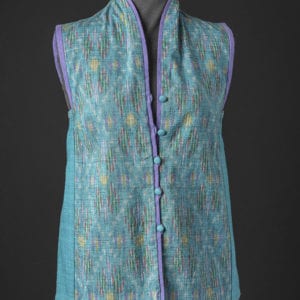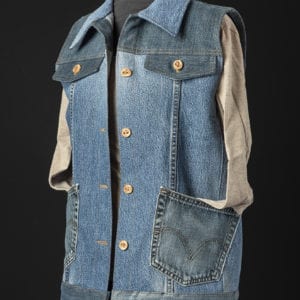
If you haven’t yet made a Tabula Rasa Vest, get started now making a vest for Fall! They are so easy to make with the Tabula Rasa Jacket pattern – just leave out the sleeve and finish the armhole edges to make a perfect vest. We tell you how in our free download, Make a Tabula Rasa Vest. These instructions were originally included with the print version of Swing Variations but were separated out when we replaced the print version with the digital pattern for Swing Variations. We hope you’ll be inspired by the variety of vest styles in our Photo Gallery.

Bind the Side Panel
The key to making a Tabula Rasa Vest is finishing the armhole. We find it is easiest to finish the top edge of the side panel with a simple binding before inserting it into the body of the vest. The fun comes in choosing which fabric to use as the binding! We also recommend that you experiment with slightly narrowing and raising the top edge of the side panel for a vest to reduce the size of the opening designed for a sleeve.

This week I’ve been working on a vest made from two pieces of double-faced cotton jaquard that were left over from some fabric bundles we sold several years ago. Because it’s double faced, I am designing the vest to be completely reversible. Here you can see I’ve bound the top of my extended vest side panels so that the lighter side will have dark accents.
Bind the Upper Armhole
The armseye portion of the armhole opening is finished after sewing the side panel into the fronts and back. We describe two methods for binding this section, both of which are illustrated with close up photos in an earlier blog post, Tabula Rasa Vests. For the “extended shoulder,” the binding is wrapped around the raw edge of the upper armhole opening without changing the width of the shoulder seam; for the “natural shoulder,” the binding is turned completely turned under, reducing the width of the shoulder seam. The method you choose may be influenced by whether you want to show an accent fabric, the nature of the fabric you are using, and where you’d like the shoulder to sit.
For my double-faced cotton vest, I ended up using a modified version of the natural shoulder technique because I had inserted the side panels with french seams. I attached the upper armhole binding with a 1/4″ seam (rather than 5/8″), then wrapped the seam allowance and turned it under. I sewed the binding to the reverse side by hand, which I generally prefer because it is softer and less visible. I also find that stitching in the ditch to secure the binding tends to stiffen the armhole opening.
Combine it with any TRJ Front
This week’s vest I am finishing with a kimono style band. I have also made vests with center fronts from Rain or Shine Variations, such as the Batik Butik Vest and Funnel Neck Ikat Vest, and with a Jean Jacket Variation front, as with this Recycled Denim Vest. Still to try… vests with Band Variations and vests that zip up the front.
You might also enjoy a look at Rae’s Double the Orient jacket made from a very similar set of fabrics. Its always fun to see how differently, or similarly, we make use of them!
Have you made a Tabula Rasa Vest? Please share a #tabularasavest photo to Instagram or Facebook to inspire our community!
Happy Sewing, Carrie
















